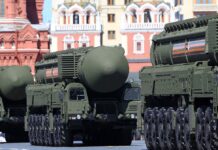A Chinese fighter jet aggressively intercepted a U.S. aircraft earlier in the month, risking the lives of its crew and escalating tensions between the two nations.
A J-16 fighter pilot “performed an unnecessarily aggressive maneuver” against a U.S. RC-135 reconnaissance plane on May 26, according to a statement released by United States Indo-Pacific Command (INDOPACOM) on May 30.
Indo-Pacific Command released a video of the incident, in which the Chinese fighter pilot aggressively cuts across the nose of the U.S. aircraft, forcing it to fly through the smaller plane’s turbulence.
The move is part of a long-running pattern of Chinese military aggression in the international airspace of the South China Sea, through which the regime has attempted to force the militaries of several nations to cease monitoring the region.
“The RC-135 was conducting safe and routine operations over the South China Sea in international airspace, in accordance with international law,” the Indo-Pacific Command statement said.
“The United States will continue to fly, sail, and operate—safely and responsibly—wherever international law allows, and the U.S. Indo-Pacific Joint Force will continue to fly in international airspace with due regard for the safety of all vessels and aircraft under international law.”
‘Tempting a Crisis’
China’s communist regime and its military wing, the People’s Liberation Army (PLA), have a long history of aggressive intercepts against nations operating in the region.
After one such incident in December 2022, Ely Ratner, Assistant Secretary of Defense for Indo-Pacific Security Affairs, said that the regime frequently risks the lives of its pilots and those of the United States with aggressive close maneuvers.
“We have PLA aircraft coming within tens of feet of allied aircraft; we have them releasing flares and chaff, we have them doing dangerous maneuvers around aircraft and, to exactly this point, it is tempting a crisis that could have geopolitical and geoeconomic implications,” Ratner said during a talk with the American Enterprise Institute on Dec. 8.
“If Beijing’s intent is to somehow intimidate the United States out of operating according to international law, that hasn’t worked [and] it’s not going to work. But it is very reckless behavior.”
In some incidents, PLA aircraft have succeeded in forcing U.S. and allied aircraft out of international airspace by releasing chaff, a countermeasure made of numerous shards of metal, into their engines mid-flight.
In one such episode in May, an Australian aircraft was forced to cut its mission short and engage in an emergency landing after PLA chaff significantly damaged its engines, threatening the lives of its crew.
“Quite obviously, this is very dangerous,” Australian Defense Minister Richard Marles said after the incident.
Weeks later, PLA fighters flew within 20 feet of a Canadian surveillance plane and presented the Canadians with the middle finger.
In that instance, the Canadian aircraft had been on an international mission to investigate whether Chinese ships were illegally breaking sanctions by delivering oil to North Korean vessels at sea.
Canada reported more than 60 such incidents in the first half of 2022.
“It is a pattern of behavior that has been growing in particular over the last year and a half or so,” Ratner said.
“On the whole, the PLA is not yet willing or serious about trying to manage this competition in a way that we would expect a responsible or aspiring major power to do so. We think that’s a huge problem.”








